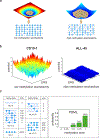Converging genetic and epigenetic drivers of paediatric acute lymphoblastic leukaemia identified by an information-theoretic analysis
- PMID: 33859388
- PMCID: PMC8370714
- DOI: 10.1038/s41551-021-00703-2
Converging genetic and epigenetic drivers of paediatric acute lymphoblastic leukaemia identified by an information-theoretic analysis
Abstract
In cancer, linking epigenetic alterations to drivers of transformation has been difficult, in part because DNA methylation analyses must capture epigenetic variability, which is central to tumour heterogeneity and tumour plasticity. Here, by conducting a comprehensive analysis, based on information theory, of differences in methylation stochasticity in samples from patients with paediatric acute lymphoblastic leukaemia (ALL), we show that ALL epigenomes are stochastic and marked by increased methylation entropy at specific regulatory regions and genes. By integrating DNA methylation and single-cell gene-expression data, we arrived at a relationship between methylation entropy and gene-expression variability, and found that epigenetic changes in ALL converge on a shared set of genes that overlap with genetic drivers involved in chromosomal translocations across the disease spectrum. Our findings suggest that an epigenetically driven gene-regulation network, with UHRF1 (ubiquitin-like with PHD and RING finger domains 1) as a central node, links genetic drivers and epigenetic mediators in ALL.
Conflict of interest statement
Competing interests
The authors declare no competing interests.
Figures






Similar articles
-
UHRF1-mediated epigenetic reprogramming regulates glycolysis to promote progression of B-cell acute lymphoblastic leukemia.Cell Death Dis. 2025 Apr 29;16(1):351. doi: 10.1038/s41419-025-07532-0. Cell Death Dis. 2025. PMID: 40301374 Free PMC article.
-
[Role of UHRF1 in methylation regulation and angiogenesis].Zhonghua Yi Xue Yi Chuan Xue Za Zhi. 2020 Feb 10;37(2):200-204. doi: 10.3760/cma.j.issn.1003-9406.2020.02.025. Zhonghua Yi Xue Yi Chuan Xue Za Zhi. 2020. PMID: 32034755 Review. Chinese.
-
UHRF1 depletion and HDAC inhibition reactivate epigenetically silenced genes in colorectal cancer cells.Clin Epigenetics. 2019 May 7;11(1):70. doi: 10.1186/s13148-019-0668-3. Clin Epigenetics. 2019. PMID: 31064417 Free PMC article.
-
Epigenetic landscape correlates with genetic subtype but does not predict outcome in childhood acute lymphoblastic leukemia.Epigenetics. 2015;10(8):717-26. doi: 10.1080/15592294.2015.1061174. Epigenetics. 2015. PMID: 26237075 Free PMC article.
-
Epigenetics in pediatric acute lymphoblastic leukemia.Semin Cancer Biol. 2018 Aug;51:129-138. doi: 10.1016/j.semcancer.2017.09.001. Epub 2017 Sep 5. Semin Cancer Biol. 2018. PMID: 28887175 Review.
Cited by
-
DNA methylation landscapes in DIPG reveal methylome variability that can be modified pharmacologically.Neurooncol Adv. 2024 Feb 19;6(1):vdae023. doi: 10.1093/noajnl/vdae023. eCollection 2024 Jan-Dec. Neurooncol Adv. 2024. PMID: 38468866 Free PMC article.
-
Artificial Intelligence-Assisted Diagnostic Cytology and Genomic Testing for Hematologic Disorders.Cells. 2023 Jun 30;12(13):1755. doi: 10.3390/cells12131755. Cells. 2023. PMID: 37443789 Free PMC article. Review.
-
DNA methylation entropy is associated with DNA sequence features and developmental epigenetic divergence.Nucleic Acids Res. 2023 Mar 21;51(5):2046-2065. doi: 10.1093/nar/gkad050. Nucleic Acids Res. 2023. PMID: 36762477 Free PMC article.
-
Optimization of diagnosis and treatment of hematological diseases via artificial intelligence.Front Med (Lausanne). 2024 Nov 7;11:1487234. doi: 10.3389/fmed.2024.1487234. eCollection 2024. Front Med (Lausanne). 2024. PMID: 39574909 Free PMC article. Review.
-
DNA methylation entropy is a biomarker for aging.Aging (Albany NY). 2025 Mar 12;17(3):685-698. doi: 10.18632/aging.206220. Epub 2025 Mar 12. Aging (Albany NY). 2025. PMID: 40096548 Free PMC article.
References
-
- Mullighan CG The molecular genetic makeup of acute lymphoblastic leukemia. Hematology Am Soc Hematol Educ Program 2012, 389–96 (2012). - PubMed
-
- Hunger SP & Mullighan CG Acute lymphoblastic leukemia in children. N Engl J Med 373, 1541–52 (2015). - PubMed
-
- Grobner SN et al.The landscape of genomic alterations across childhood cancers. Nature 555, 321–327 (2018). - PubMed
Publication types
MeSH terms
Substances
Grants and funding
LinkOut - more resources
Full Text Sources
Other Literature Sources
Molecular Biology Databases

